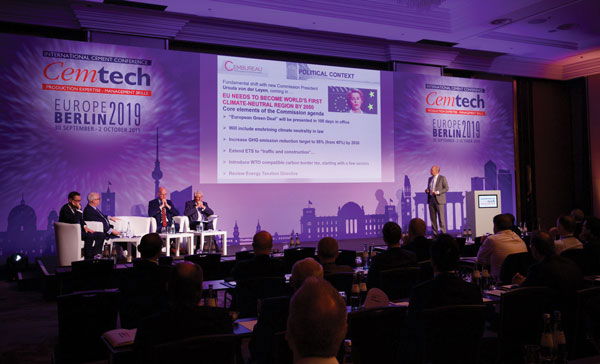Cemtech Europe 2019 opened today at the InterContinental Hotel in Berlin, Germany. Taking place as global sustainability targets tighten, the conference agenda will closely examine the current market trends and environmental targets of the European cement industry.

Cemtech Europe 2019 opened today at the InterContinental Hotel in Berlin, Germany,
highlighting the sustainability achievements and targets of the global cement industry
Opening the conference, Thomas Armstrong, managing director of International Cement Review, welcomed delegates to Berlin and outlined the sustainability goals of the industry, while also introducing an exciting array of speakers.
Martin Schneider, CEO of VDZ (Germany), followed this by looking at market trends and technological developments in the German cement industry. Regarding the country’s future, Mr Schneider noted that “these are historical days”and “that production is still expected to grow further”. Following 29Mt of consumption in 2019, VDZ forecasts “stable consumption for the years to come”.
Addressing the sustainability theme, Mr Schneider stated that the Paris Agreement “requires dramatic measures in all sectors and in our own”. Additionally, the phasing out of coal and fossil fuel power plants by 2038 is expected to have a knock-on effect on the availability of supplementary materials such fly ash and lignite.
However, the cement industry requires the support of legislation and end-users to meet sustainability targets. “Targets for clinker efficiency are very ambitious, but we need good support, it can’t be the cement industry alone.” “If we come up with clinker-efficient cements, we must make sure they are bought”.
“At the end, as an industry we will have a bright future,” said Mr Schneider.
Taking a wider scope, Koen Coppenholle, CEO of CEMBUREAU, the European cement association, provided a political context for the industry by looking at the European Commission’s goal for the EU to become the world’s first climate-neutral region by 2050, with this expected to be enshrined in law. Mr Coppenholle also considered the solutions the cement industry can offer along its value chain to reduce emissions. Echoing Martin Schneider’s comments, Mr Coppenholle highlighted the importance of joint partnerships across the sector to meet these ambitious targets. As an example, he noted that “further uptake of alternative fuels doesn’t depend on technology, it depends on regulation.” Set in 2013, the goals of the association are to see a 32 per cent reduction in CO2 emissions from the cement industries of its member countries by 2050. Currently, they have reached a 14 per cent reduction and therefore, are on track to meet the goal.
Jean-Christophe Lefèvre-Moulenq, CM-CIC (France), looked at market developments and corporate transformation across the sector. In particular, he considered the impact of Chinese producers, overcapacity in Africa and how the EU ETS regulations may well reduce the number of smaller producers and result in market consolidation.
Peter Lukas of HeidelbergCement (Germany) outlined the company’s climate protection strategy and Vision 2050. Since the producer has a goal to achieve carbon neutrality by 2050, the presentation looked at its current projects for implementation and application of low-carbon technologies, such as its LEILAC project. Mr Lukas also noted necessary framework conditions, both technological and regulatory, which will enable deep decarbonisation.
The rest of the programme for the first day includes LafargeHolcim exploring its ‘Plants of Tomorrow Initiative’, which targets a global network of over 270 integrated cement plants and grinding stations across more than 50 countries. The presentation will feature the Westküste 100 case study for CO2 capture and conversion into a valuable product.
Another programme highlight from the first day includes Jan Baeyens’ examination of the SOLPART project, which aims to deliver a solar reactor suitable for cement raw meal calcination. The plans include simulating a 24/7 industrial process, which could reduce CO2 emissions by 40 per cent in the cement and lime industry.
The conference programme will continue tomorrow and is supported by a full international exhibition of leading manufacturing solution specialists, including those in the fields of grinding, pyroprocessing, online analysers, conveying, dust collection, coolers, logistics and alternative fuels.
The event is scheduled to conclude tomorrow with a Gala Dinner and the ICR Awards ceremony. For the full list of shortlisted nominees for the awards, please visit: https://www.cemnet.com/Conference/Item/183061/ICR-Cement-Industry-Awards-2019.
For updates from the conference, please visit:
Twitter:
https://twitter.com/CemtechConf
Flickr:
https://www.flickr.com/photos/cementconference/albums/72157711144851607
